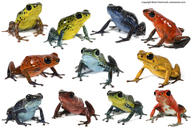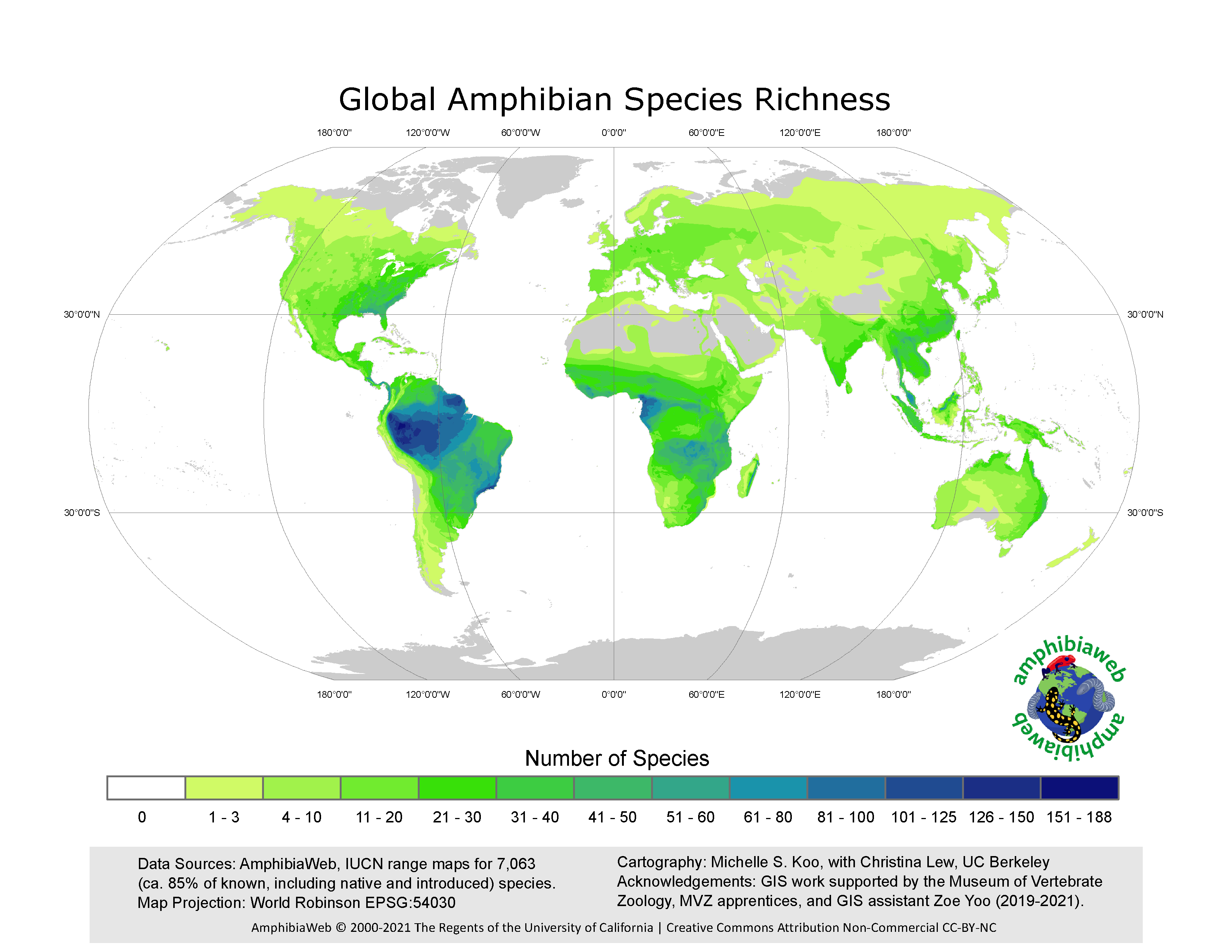Navigate to Decline Factors below:
Amphibian Conservation
Why save amphibians? What is the scope of the problem, what are the causes, and what can be done?
Update in progress by AmphibiaWeb's Conservation Working Group, October 2021
Originally posted by Vance Vredenburg, Kellie Whittaker, Michelle Koo, February 13, 2014
- Why Save Amphibians?
- Introduction- Scope of the Crisis
- Maps of Global Declines
- Why are Populations Declining?
- Factors of Amphibian Decline and Conservation Action Links
- Literature Cited
Why Save Amphibians?
Written by Julianne Oshiro, 15 March 2021
While these little creatures may go unnoticed by most of us, amphibians have greatly influenced our society and planet’s ecosystems. Amphibians have helped to advance the field of medicine, are integral to the ecosystems on which we rely, and are central to many cultural stories and beliefs.
Much of the fascinating biology of amphibians have applications beyond understanding their evolution and ecology. The valuable chemicals that amphibians exude from their skin have already been used in medicine to combat drug-resistant bacteria, cardiac problems, and HIV (Song et al. 2010). For example, amphibians are a valuable model for researchers to study regenerative tissue (Garg et al. 2007). Salamanders, such as the Ambystoma mexicanum, have the ability to regrow limbs, which brings hope that one day doctors will be able to help those with amputated limbs to regrow tissue (Voss et al. 2009).
Amphibians are central to maintaining a healthy and resilient ecosystem. And because of their permeable skin, amphibians are extremely vulnerable to environmental and water quality degradation. Thus, their decline is an important indicator that an entire ecosystem may be in peril. Amphibians play a crucial role in an ecosystem’s nutrient cycles. For example, salamanders help to spread out the release of essential minerals found in leaf litter by consuming decomposers, thereby allowing for soils to retain their nutrients for a longer period of time (Davic and Welsh 2004). Many species migrate between aquatic and terrestrial ecosystems and thus serve as an important connection through which energy and matter can flow between ecosystems, and thereby, enhancing the resilience of both ecosystems (Best and Welsh 2014). Amphibians regulate the food chain. Many other animals, such as lizards, birds, fish, and snakes, to name a few, rely on amphibians for food. It has been shown that a decrease in amphibian populations can lead to a decline in species diversity and overall health for the amphibian’s predator populations (Zipkin et al. 2020). Amphibians, especially as tadpoles, consume algae, which helps to clean lake water and prevent eutrophication, and insects, which helps to control the population of mosquitoes and limit the spread of disease in humans (Rubbo et al. 2011). It is clear that the rapid extinction of amphibian species will have rippling, negative consequences all throughout an ecosystem and its food chain.
Lastly, amphibians are beautiful creatures that have been celebrated in many cultures for thousands of years. The bright, colorful patterns of the poison dart frog (family Dendrobatidae) are awe-inspiring and the translucent skin of the glass frog (family Centrolenidae) is fascinating. For this reason, frogs are often kept as pets and depicted in art. In Peru, archaeologists have found toads portrayed in a mural dating back nearly 4,000 years ago as symbols for rain during a period of scarcity and famine (BBC News 2019).Across the world, frogs are both consumed as a delicacy, like in France and China, and as a central part of a culture’s diet, as with the people of Burkina Faso (e.g., Mohneke et al 2011). Frogs are found in popular media today, with characters such as Kermit the Frog from The Muppets and Disney’s movie adaptation, The Princess and the Frog. Protecting these creatures will not only benefit our society but also ensure that future generations will enjoy the wonders of amphibians and a healthy planet.
Scope of the Crisis
Written by AmphibiaWeb, April 2021
Amphibians, a unique group of vertebrates containing over 8,200 known species, are threatened worldwide. A 2004 global assessment (Baillie et al (eds) 2004) found that nearly one-third of the world's amphibians are threatened, representing 1,856 species. Amphibians have existed on earth for over 300 million years, yet in just the last three decades there have been an alarming number of extinctions, nearly 168 species are believed to have gone extinct and over 43% more have populations that are declining. This indicates that the number of extinct and threatened species will probably continue to rise (Stuart et al. 2004).
To understand the scope of global declines, an introduction to amphibian biodiversity is useful. Amphibian diversity is highest in the tropics, especially in the Amazon. Brazil has the most described species, over a 1,000 species. By contrast, the United States (or search by State) is nearly the same size as Brazil with about a third of the amphibian species (although it has many more salamanders!).
We compiled this amphibian richness map by calculating the overlapping ranges of all known amphibians. Data sources combine work from AmphibiaWeb GIS and IUCN range maps. We update this figure every year or two.Map of Global Declines
A global map of threatened species highlights where the most vulnerable and endangered species are concentrated. There are now threatened hotspots on every continent, with particularly alarming increases in the western North America in the California Floristic Province, Mesoamerica and the Caribbean, western Africa in the Gulf of Guinea, Asia and Southeast Asia and southeastern Australia.

Download the map as pdf here.
Why Are Amphibian Populations Declining?
Clearly, the most important factor leading to amphibian population declines is habitat destruction. When forests are cleared it is no surprise that species that once lived there disappear. What is alarming is that there are many cases where the habitat is protected and amphibians are still disappearing. The causes for recent amphibian declines are many, but an emerging disease called chytridiomycosis and global climate change are thought the be the biggest threats to amphibians. Chytridiomycosis is a disease caused by the fungal chytrid pathogen Batrachochytrium dendrobatidis. This pathogen is associated with the global loss of hundreds of species of amphibians and represents a spectacular loss of biodiversity, some say the worst in recorded history.
In the table below, we break down all of the hypothesized factors and the links provide more detailed information for each one. Some factors are obviously shared with other types of endangered species on our planet and are part of to the worldwide biodiversity crisis such as habitat destruction, alteration and fragmentation (Fisher and Shaffer 1996, Davidson et al. 2001, Marsh and Trenham 2001), introduced species (Vredenburg 2004, Kats and Ferrer 2003) and over-exploitation (Jennings and Hayes 1985, Lannoo et al. 1994). For these threats, we have a pretty good understanding of the ecological mechanisms underlying declines (Collins and Storfer 2003). However, amphibians have also declined in relatively "pristine" and protected environments (Wake 1991, Crump et al. 1992, Lips 2000). These more complex and elusive mechanisms include climate change (Pounds et al. 1999, Kiesecker et al. 2001, Carey and Alexander 2003), increased UV-B radiation, chemical contaminants (Hayes et al. 2002, Blaustein et al. 2003), emerging infectious diseases (Daszak et al. 2003) and deformities (or malformations). The underlying mechanisms behind these factors are complex and they may be working synergistically with more straight forward factors, such as habitat destruction and introduced species, to exacerbate declines (Kiesecker et al. 2001, Blaustein and Kiesecker 2002). Researchers are finding that there is not a single overarching cause for global declines, instead all of these factors are threatening amphibian populations and the threat tends to vary depending on the location. If we are going to prevent further extinctions, research must move forward quickly and be used effectively in management by governments and non-governmental organizations around the world.
Factors in Amphibian Declines
Click on the Titles Below to Read More
Literature Cited
Alford, R. A., and S. J. Richards. 1999. Global amphibian declines: A problem in applied ecology. Pages 133-165 in Annual Review of Ecology and Systematics. Annual Reviews, Palo Alto.
BBC News. 20 Aug. 2019. “Mural from 3,800 Years Ago Unveiled by Peru Archaeologists.” BBC, www.bbc.com/news/world-latin-america-49407795.
Best, M. L. and H. H. Welsh, Jr. 2014. The Trophic Role of a Forest Salamander: Impacts on Invertebrates, Leaf Litter Retention, and the Humification Process. Ecosphere, 5(2) doi:10.1890/es13-00302.1.
Blaustein, A. R., and J. M. Kiesecker. 2002. Complexity in conservation: Lessons from the global decline of amphibian populations. Ecology Letters 5:597-608.
Blaustein, A. R., J. M. Romansic, J. M. Kiesecker, and A. C. Hatch. 2003. Ultraviolet radiation, toxic chemicals and amphibian population declines. Diversity & Distributions [print] 9:123-140.
Blaustein, A. R., and D. B. Wake. 1990. Declining amphibian populations - a global phenomenon. Trends in Ecology & Evolution 5:203-204.
Carey, C., and M. A. Alexander. 2003. Climate change and amphibian declines: is there a link? Diversity and Distributions 9:111-121.
Collins, J. P., and A. Storfer. 2003. Global amphibian declines: Sorting the hypotheses. Diversity & Distributions [print] 9:89-98.
Connelly, S., Pringle, C.M., Bixby, R.J. et al. 2008. Changes in Stream Primary Producer Communities Resulting from Large-Scale Catastrophic Amphibian Declines: Can Small-Scale Experiments Predict Effects of Tadpole Loss?. Ecosystems 11:1262–1276. https://doi.org/10.1007/s10021-008-9191-7
Crump, M. L., F. R. Hensley, and K. L. Clark. 1992. Apparent decline of the Golden Toad: underground or extinct? Copeia 1992:413-420.
Daszak, P., A. A. Cunningham, and A. D. Hyatt. 2003. Infectious disease and amphibian population declines. Diversity & Distributions [print] 9:141-150.
Davic, R. D., and H. H Welsh. 2004. On the Ecological Roles of Salamanders. Annual Review of Ecology, Evolution, and Systematics, 35(1):405–434. doi:10.1146/annurev.ecolsys.35.112202.130116.
Davidson, C., H. B. Shaffer, and M. R. Jennings. 2001. Declines of the California red-legged frog: Climate, UV-B, habitat, and pesticides hypotheses. Ecological Applications 11:464-479.
Fisher, R. N., and H. B. Shaffer. 1996. The decline of amphibians in California's Great Central Valley. Conservation Biology 10:1387-1397.
Garg, Abhishek D, et al. 2007. Toad Skin-Secretions: Potent Source of Pharmacologically and Therapeutically Significant Compounds. The Internet Journal of Pharmacology 5( 2) doi:10.5580/18b6.
Hayes, T. B., A. Collins, M. Lee, M. Mendoza, N. Noriega, A. A. Stuart, and A. Vonk. 2002. Hermaphroditic, demasculinized frogs after exposure to the herbicide atrazine at low ecologically relevant doses. Proceedings of the National Academy of Sciences of the United States of America 99:5476-5480.
Houlahan, J. E., C. S. Findlay, B. R. Schmidt, A. H. Meyer, and S. L. Kuzmin. 2000. Quantitative evidence for global amphibian population declines. Nature 404:752-755.
Jennings, M. R., and M. P. Hayes. 1985. Pre-1900 overharvest of California [USA] red-legged frogs (Rana aurora draytonii): The inducement for bullfrog (Rana catesbeiana) introduction. Herpetologica 41:94-103.
Kats, L. B., and R. P. Ferrer. 2003. Alien predators and amphibian declines: Review of two decades of science and the transition to conservation. Diversity & Distributions [print] 9:99-110.
Kiesecker, J. M., A. R. Blaustein, and L. K. Belden. 2001. Complex causes of amphibian population declines. Nature 410:681-684.
Lannoo, M. J., K. Lang, T. Waltz, and G. S. Phillips. 1994. An altered amphibian assemblage: Dickinson County, Iowa, 70 years after Frank Blanchard's survey. American Midland Naturalist 131:311-319.
Lips, K. R. 2000. Decline of a tropical amphibian fauna. in 166th National Meeting of the American Association for the Advancement of Science (AAAS) and Science Innovation Exposition., Washington, D.C., USA, February 17-22, 2000.
Marsh, D. M., and P. C. Trenham. 2001. Metapopulation dynamics and amphibian conservation. Conservation Biology 15:40-49.
Mohneke, M, et al. 2011. Medicinal and Dietary Uses of Amphibians in Burkina Faso. African Journal of Herpetology 60(1):78–83. doi:10.1080/21564574.2011.564660.
Pounds, A., M. Fogden, and J. Campbell. 1999. Biological response to climate change on a tropical mountain. Nature 398:611-614.
Rubbo, M. J., et al. 2011. The Influence of Amphibians on Mosquitoes in Seasonal Pools: Can Wetlands Protection Help to Minimize Disease Risk? Wetlands. 31(4):799–804. doi:10.1007/s13157-011-0198-z.
Song, Fengyu, et al. 2010. Amphibians as Research Models for Regenerative Medicine. Organogenesis. 6(3):141–150. doi:10.4161/org.6.3.12039
Stuart, S., Chanson, J.S., Cox, N.A., Young, B.E., Rodrigues, A.S.L., Fishman, D.L. and Waller, R.W. 2004. Status and trends of amphibian declines and extinctions worldwide. Science 306: 1783-1786.
Voss, S. R., Eppertain, H.H., and Tanaka, E.M. 2009. Ambystoma mexicanum, the Axolotl: A Versatile Amphibian Model for Regeneration, Development, and Evolution Studies. Cold Spring Harbor Protocols. 2009(8). doi:10.1101/pdb.emo128
Vredenburg, V. T. 2004. Reversing introduced species effects: Experimental removal of introduced fish leads to rapid recovery of declining frog. Proceedings of the National Academy of Sciences 101(20):7646-7650.
Wake, D. B. 1991. Declining amphibian populations. Science 253(5022):860. DOI: 10.1126/science.253.5022.860
Young, B. E., K. R. Lips, J. K. Reaser, R. Ibanez, A. W. Salas, J. R. Cedeno, L. A. Coloma, S. Ron, E. La Marca, J. R. Meyer, A. Munoz, F. Bolanos, G. Chaves, and D. Romo. 2001. Population declines and priorities for amphibian conservation in Latin America. Conservation Biology 15:1213-1223.
Zipkin EF, DiRenzo GV, Ray JM, Rossman S, Lips KR. 2020. Tropical snake diversity collapses after widespread amphibian loss. Science. 367(6479):814-816. doi: 10.1126/science.aay5733.



